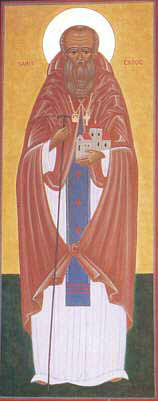St Gildas the Wise (January 29)
29 Ιανουαρίου 2011

He was probably born about 517, provably in the North of England or Wales. His father’s name was Cau (or Nau) and that he came from noble lineage. He probably had several brothers. It is likely that one of these, Cuil (or Hueil), was killed by King Arthur (who died in 537 AD). It also appears that he may have forgiven Arthur for this.
He lived in a time when the glory of Rome was faded from Britain. The permanent legions had been withdrawn by Maximus, who used them to sack Rome itself and make himself Emperor.
He was noted for his piety and well educated, and was not afraid of publicly rebuking contemporary monarchs, at a time when libel was answered by a sword, rather than a Court order.
Gildas lived for many years as a very ascetic hermit on Flatholm Island in the Bristol Channel. Here he established his reputation for that peculiar Celtic sort of holiness that consists of extreme self-denial and isolation. At around this time, according to the Welsh, he also preached to Nemata, the mother of St David, while she was pregnant with the Saint. Read more…
In about 547 he wrote a book De Excidio Britanniae (The Destruction of Britain). In this he writes a brief tale of the island from pre-Roman times and criticizes the rulers of the island for their lax morals and blames their sins (and those that follow them) for the destruction of civilization in Britain. The book was avowedly written as a moral tale.
He also wrote a longer work, the Epistle. This is a series of sermons on the moral laxity of rulers and of the clergy. In these Gildas shows that he has a wide reading of the Bible and of some other classical works.
He was also a very influential preacher, visiting Ireland and doing much missionary work. He was responsible for the conversion of much of the island and may be the one who introduced anchorite customs to the monks of that land.
He retired from Llancarfan to Rhuys, in Brittany, where he founded a monastery. Of his work on the running of a monastery (one of the earliest known in the Christian Church), only the so-called Penitential, a guide for Abbots in setting punishment, survives.
He died around 571, at Rhuys. The monastery that he had founded became the center of his cult.
He is regarded as being one of the most influential figures of the early English Church. The influence of his writing was felt until well into the middle ages, particularly in the Celtic Church. He is also important to us today as the first British writer whose works have survived fairly intact.



